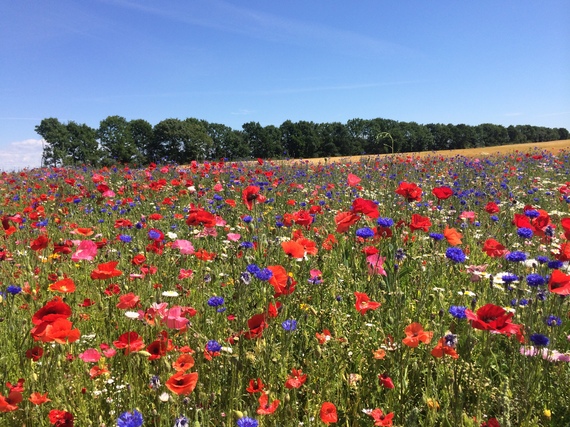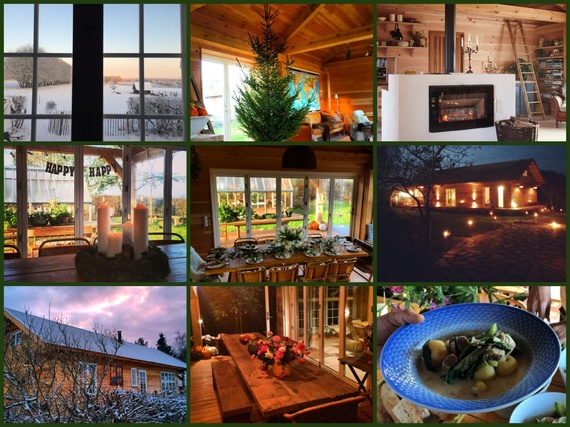How ordinary people's everyday actions are the key to our green future.
At the Paris summit, civil society, climate activists and grass root movements were addressed again and again. "We would not be where we are today; here in Paris, with 196 parties adopting a global climate change agreement, without the leadership and vision of our civil society" Mr. Ban Ki Moon insisted. And he added that after the COP21 summit is over, the voices of the grassroots and civil society will be needed more than ever: To put pressure on governments to be more ambitious. And to show the world what is possible in terms of lifestyle changes and green solutions in all that we do.
We know for sure, that if we want to leave the planet a breathable, livable and edible habitat for our children and the next generations to come, we have to make some severe lifestyle changes. And those of us living and spending in the most industrialized parts of the world have to change the most. Every household and every decision made about our consumption has to be considered and possibly changed in order to change our environmental impact.
Anemic hippies unite
But here is the thing: Green lifestyle changes have had bad PR. We - the climate activists who advocates for a greener lifestyle are often ridiculed as idiots. You know we are the forever breastfeeding vegan anemic hippies with chronically bad hair days and free range chickens running wild in our messy homes alongside our free range kids on a "no sugar" diet.
Can you hear the carbon lobbyist and the conservative big spenders laugh? I know I can.
We have been laughed at. Oh yes. But after the summit we are the one's to laugh. Radical lifestyle changes are agreed on by the official world. Radical life style changes can save our planet. And radical lifestyle changes need a radical Public Relations- makeover to accelerate the movement toward better choices that is already taking root with those of us less afraid of the anemic hippie label. I myself - a pretty grown up female journalist - are often referred to as "a garden girl" here in Denmark, where I live. To soften my point, I guess.
To put effect on our new PR-strategy for radical lifestyle changes we need to work from two fronts: In my opinion, we need to make green choices smoking hot. We need to make the green lifestyle so desirable that it is the only choice anyone in the right mind would want to make. Not only because it's the (boring) right thing to do, but also because it's the smart and trendy thing to do.
Going Green improves quality of life. It's more fun. It's more personal. It looks good! It's good personal branding. Keep the good reasons coming... In order to do exactly that we need to share our own everyday stories of how we live the good life with our green lifestyle, share our How To Do's and share our own personal success stories. We are on a mission here as members of the civil society leading the way and showing the world, that this is not only fun, but it's attractive to Go Go Go Green!
And have you noticed? Nothing looks as desirable on Instagram as green lifestyle. Nothing looks true and real and authentic as a cabin in the mountains built out of wood and a bunch of flowers picked from the field. I urge everyone who is out there, doing their bit going green: We needs you to join the green PR team and remember the storytelling lesson of this century: Nothing is as "instagrammable" as a green lifestyle!
Which brings me to the other front. Industry giants. Business will be business and business needs profit. But this year at the Paris summit, more than 2,400 companies and investors shared their efforts towards minimizing emissions on the COP21 portal, making the (necessary) engine behind our collective pollution part of the idea pool for solutions. And it's on the companies to make this new, attractive lifestyle as easy and convenient as anything they ever produced, because the next generation of consumers are all about convenience and might not trade their Black Friday feasts for sharing economy swaps if it isn't the easiest thing to do.
The empowered youth
The next generation of consumers is often referred to as 'The Millenials'. They are demanding consumers that grew up in the digital age. They are empowered by technology and choices and expect things to work or else they abandon them for easier options. Now, you might think this generation is ethically unscrupulous, too, but no: They are perhaps the first generation of consumers that are fully focused on values before qualities. They know a thing or two about sustainability. The Millenials want to know why brands do what they do and to which effect. And if they don't like what they hear - or if they hear nothing - they move on to a brand that delivers to the values that fit their personal (sustainable) preferences.
That's why we need to get the business on board, too. They need to be behind our PR team, delivering affordable products to the mainstream that match our real life examples, producing the solutions that make reducing, reusing and recycling easy, convenient and desirable. This is what it takes. This is how we can make the climate agreement from Paris happen from the ground up.
My 'Little House on the Prairie' prototype
Allow me to share a personal story. My generation is (as it is said) the first generation to feel the effect of climate change and the last generation who can do something about it. And to illustrate how this really is within reach for all of us, I want to tell you the story of my 'little house on the prairie'. See, I'm just a single mom from Copenhagen. I'm a journalist, as you've heard, but I am also an activist on a mission to do my bit for the environment and get as many on board as I possibly can. I am sure, that If I can do it, everybody can do it. In this case building sustainably.
Early on in my career, I realized that I could combine my pragmatic knowledge about natural resources from growing up in the rural countryside - with my abilities to communicate both visually and in written form. By doing what I love, I could inspire others to improve their quality of life as well as help the environment through my topics such as urban gardening, animal welfare and every-day-sustainability.
My efforts have up until now have been centered around down-to-earth practical sustainability solutions that anyone can implement in their daily lives; gardening, cooking, organic consumption, reduction of food waste and so on. But almost by chance, falling in love with a small piece of land near the north coast of Zealand, I started researching the environmental impact of our homes, too. The very buildings we live in. And I was taken by surprise by what I found. Let me quote a UNEP-report: "It is estimated that at present, buildings contribute as much as one third of total global greenhouse gas emissions, primarily through the use of fossil fuels during their operational phase".
If I were to build on this beautiful piece of land, I knew I would have to build differently. I would have to - yes, over time and as I researched, I felt obliged to - try to invent some sort of prototype for a non-compromising 100% sustainable house. One that didn't cost more that an ordinary house. One that wasn't any more complicated to build. One that was achievable for everyone, setting a new standard for our sustainable future.
And that was how I came to build the first private FSC-certified house on pillars in the world, made entirely out of the only CO2-positive building material we have: Wood.
The story of my sustainable house is a personal story of my journey through materials, choice of local carpenters, hunts for second hand furniture and endless frustrations and doubts that I think characterize any building project. And it is a story of how positive green PR on social media works to motivate others to do the same. It is also a story about CO2-positive architectural innovation, circular economy and yet another New Nordic Manifesto, namely one on sustainable building methods. As well as it is a story of an old man with a barn full of salvaged wood windows from all over the country, of how timber put a side for restoring the royal castles ended up in this tiny timber cabin and of how Wham's 'Last Christmas' came alive last year when we celebrated our first Christmas in the idyllic "Bramble House" - named after the brambles on the lot. It was - as you might have guessed - quite "intagrammable" and by that served it's purpose doing storytelling for the "Radical Lifestyle change Go Green PR-department".
Merry Christmas!
Please note: This is part one of a series of three posts. In my next post I will tell you the story of The Bramble House, show you the manifesto for New Nordic Building Methods and share some of the moving anecdotes from the intense building process and continuous hunt for sustainable materials that resulted in the FSC certified prototype. Part three is about 'House Therapy' - how modern buildings sometimes work against us and make us ill, and what we can do to prevent it.
Meanwhile, let's kick-start the green PR movement: Share your stories of everyday sustainable solutions for a green lifestyle. Use your blog, Pinterest, Instagram, any social media you like to tell the world how you solve the climate crisis. Let's make the transition easy and fun - and show the world how attractive it is to sustain our future habitat.

